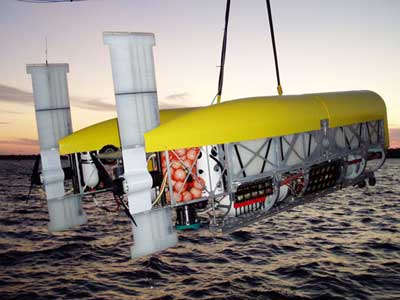A new type of robotic vehicle called Nereus has successfully reached the deepest part of the world’s ocean.
Nereus dived to 10,902m (6.8 miles) in the Mariana Trench in the western Pacific Ocean on 31 May, making it the world’s deepest-diving vehicle.
The unmanned vehicle itself was remotely operated by pilots aboard the surface ship Kilo Moana via a lightweight, thin, fibre-optic tether that allowed it to reach the record depth.
The Nereus engineering team, led by Andy Bowen from the Woods Hole Oceanographic Institute, knew that, to reach this depth, a tethered robot using traditional technologies would be prohibitively expensive to build and operate. So they used innovative methods to strike a balance between size, weight, materials cost and functionality.
The tethering system presented one of the greatest design challenges. Traditional robotic systems use a steel-reinforced cable containing copper wires to power the vehicle and optical fibres to enable information to be passed between the ship and the vehicle. But if such a cable had been used to reach the seafloor in the Mariana Trench, it would have snapped under its own weight.
To solve this challenge, the Nereus team adapted fibre-optic technology developed by the US Navy’s Space and Naval Warfare Systems Center Pacific (SSC Pacific) to carry real-time video and other data between the Nereus and the surface crew. Similar in diameter to a human hair and with a breaking strength of only 4kg (8.8lb), the tether is composed of glass-fibre core with a very thin protective jacket of plastic.
Nereus has approximately 40km (25 miles) of cable in two canisters the size of large coffee cans that spool out the fibre as needed. By using this very slender tether instead of a large cable, the team was able to decrease the size, weight, complexity and cost of the vehicle.
Another weight-saving technique was the use of ceramic spheres for flotation. Each of Nereus’s two hulls contains approximately 800 of roughly 9cm (3.5in) hollow spheres, precisely designed and fabricated to withstand crushing pressures.
Engineers also modified a hydraulically operated robotic manipulator arm to operate under intense pressure and make effective use of the vehicle's limited battery power.
With its tandem hull design, Nereus weighs nearly three tons in air and is about 4.25m (14 feet) long and 2.3m (nearly 8 feet) wide. It is powered by more than 4,000 lithium-ion batteries, similar to those used in laptop computers, but have been tested to be used safely and reliably under the intense pressure of the depths.

Photo of Nereus taken during a test cruise off Hawaii in 2007. On 31 May 2009, Nereus dived to the Challenger Deep in the Mariana Trench. The dive makes Nereus the world’s deepest-diving vehicle and the first vehicle to explore the Mariana Trench since 1998
On its dive, Nereus spent more than 10 hours on the bottom, sending live video back to the ship through its fibre-optic tether and collecting geological and biological samples with its manipulator arm.




Glasgow trial explores AR cues for autonomous road safety
They've ploughed into a few vulnerable road users in the past. Making that less likely will make it spectacularly easy to stop the traffic for...